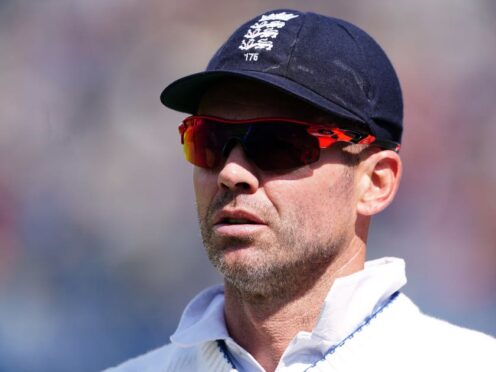
James Anderson took his 700th Test wicket as England lost the fifth Test against India in Dharamsala.
Anderson is the leading Test wicket-taker among seam bowlers, behind only spin greats Muttiah Muralitharan and Shane Warne in the overall list.
Here, the PA news agency looks at his career record.
Record-breaker

Anderson and his long-time new-ball partner Stuart Broad are two of only five bowlers ever to take 600 or more Test wickets, a list headed by Sri Lanka star Muralitharan’s remarkable 800.
Warne is next up with 708 for Australia, with Anderson following on exactly 700, Anil Kumble 619 and Broad 604. Anderson’s average of 26.53 ranks third in that group behind Muralitharan (22.73) and Warne (25.42), with Broad at 27.69 and Kumble 29.65.
Anderson has 32 five-wicket hauls, 12 more than Broad but behind the three spinners and seventh overall in Test cricket. Muralitharan is again out in front with a scarcely believable 67, with Warne’s 37 ranking second among all Test bowlers. Kumble took 35.
Four other bowlers have taken over 500 wickets – Australia seamer Glenn McGrath and spinner Nathan Lyon with 563 and 527 respectively, West Indies great Courtney Walsh on 519 and India spinner Ravichandran Ashwin, who reached 516 after taking 26 in the five-Test series against England.
Vintage performer

One of the more remarkable aspects of Anderson’s Test career is the way he has improved with age.
From the start of 2014, when he was already 31 with the wear and tear of 91 Tests as a new-ball paceman in his legs, he has more than doubled his tally of games and taken an astonishing 360 further wickets at 22.67.
Only 23 bowlers including Anderson have that many wickets in their full Test career and, of those, only three have an average lower than his in that phase – West Indies greats Malcolm Marshall at 20.94 and Curtly Ambrose at 20.99, and McGrath at 21.64.
That is boosted by 123 wickets at 24.08 since the start of 2020, despite passing his 40th birthday along the way.
Hundred at HQ

Anderson is one of only four bowlers to take over 100 Test wickets at a single venue, capturing 119 at Lord’s to Broad’s 113.
Muralitharan achieved the feat at three different grounds – 166 at Colombo’s SSC, 117 in Kandy and 111 at Galle, where fellow Sri Lanka spinner Rangana Herath took 102.
Anderson’s record at Trent Bridge may be even more impressive than at HQ, with 73 wickets at a stunning average of 19.23 across 12 Tests. The Lancastrian has 38 at 23.58 on his home ground of Old Trafford.

Enjoy the convenience of having The Sunday Post delivered as a digital ePaper straight to your smartphone, tablet or computer.
Subscribe for only £5.49 a month and enjoy all the benefits of the printed paper as a digital replica.
Subscribe